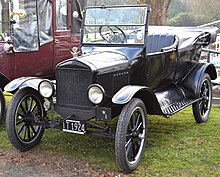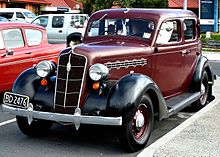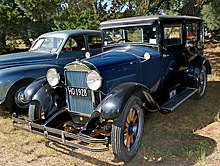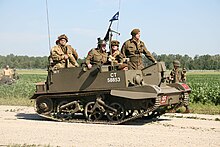Automotive industry in New Zealand
These used cars met the local need for high ownership levels in a financially straitened world but since that time continue to arrive in such large numbers they substantially increase the average age of the nation's fleet.
[1] The tiny home market—the size of a large city — and distance from potential export customers combined with first-world pay rates against the formation of any significant indigenous manufacturers.
[15] Petrol or Benzine was not readily available except as a lighting fuel for certain lamps and in some instances for sufficient quantity owners had to order it from Sydney, Australia.
The great success of the original Morris Oxford arose from its ease of driving and its reliability, both attributed to all the mechanical components being of USA design if not provenance.
The prosperity of country districts with the bad roads and the demand for big strongly built economically priced American cars did not revive until the end of the decade or the outbreak of war.
Unless they bought their erstwhile distributor and with that business its entitlement to the necessary licences without the history car manufacturers could not enter the New Zealand market but this new factor had no effect until after the war.
All locally assembled cars were their manufacturer's most basic, stripped-down versions with a tiny number of honourable exceptions, the brief post-war runs of Jaguars or Rovers etc.
Any Government intervention was designed to protect the New Zealand car assembly and related industries and to reduce the effect of vehicle purchases on the country's balance of payments with the rest of the world.
[48] In late 1929 GM was able to report the following locally sourced materials were used in their cars: wool in the upholstery, Miro timber for commercial bodies, varnishes, glues, enamels and numerous small parts, glass would shortly be added.
A large new plant at Trentham in the Hutt Valley was opened in 1967, where General Motors built such vehicles as the Australian Holden HQ series and UK Vauxhall Viva during the 1970s and Commodore during the 1980s.
[55] The new factory was formally opened by Prime Minister George Forbes on 17 February 1932 in the presence of among others the chairman of the Development of Industries Board and the Rover managing director from England.
[57] In February 1932 Rover Coventry announced strengthening of their Family Ten chassis by using heavier gauge material and re-designed cross members to improve torsional rigidity.
[64] Commentators expressed concern that this was a short step from a total takeover of the country's import trade and at least would allow the government to issue licences in such proportions and to such persons or businesses as it might choose.
[65] The minister's announcement was greeted by the chairman of the Primary Producers Federation with the description: "the Hitler plan" adding (even if it was a) "retreat from the Moscow road".
[66] The purpose was to conserve foreign exchange and to protect local industry, in particular to promote manufacturing to improve employment opportunities and to reduce the economy's reliance on the rural sector.
A rationalisation scheme was underway when a new government elected in July 1984 found it was facing a foreign exchange crisis and chose to deal with the economic situation with these new tools.
[79] In late 1935 the Ford Motor Company of Canada announced from Windsor Ontario that construction of a new assembly plant would begin immediately at Wellington and it would be ready to operate on 1 July 1936.
[31] Christchurch production stopped 24 August 1965 and all its plant and machinery was moved more than 400 kilometres to Nelson and into a never-used 100,000 square foot building on a 27 acres site intended for a cotton mill but abandoned in mid 1962.
[94] In the new Newmarket plant the body shell was removed from the wooden case of its export packaging which also held its matching chassis and pre-assembled engine, gearbox and back axle units.
In March 1939 a consortium of South Island dealers announced a new assembly plant would be built in Christchurch on a six and a half acre block beside the Christchurch-Lyttelton railway line.
The volume for private car owners was eased or constricted as the nation's circumstances permitted partly because tankers on a run to New Zealand were unavailable for a long time and in any case the government welcomed reduced foreign currency payments.
[125] Manufacturers like Toyota were unable to establish their own assembly plants because New Zealand's import licensing system granted licences by marque to existing franchise holders.
Other Japanese manufacturers followed Nissan with Toyota Coronas (and later Crowns) being assembled by Steelbro in Christchurch and Campbell Motor Industries (CMI) in Thames building the Corolla from the late 1960s.
[130] New Zealand Motor Corporation first built Hondas in Petone in 1976, adding Mount Wellington later and eventually consolidating at the former Jaguar/Triumph/Rover/Land Rover plant in Nelson.
In this period the world's fourteen largest motor companies were: At that time products of each of them were assembled in New Zealand except in the case of Citroen, Daimler-Benz and Volvo.
The report of the Institute's study claimed that limiting the then-current production levels to one or two models assembled by one or two plants would bring significant savings from economies of scale.
[147] In 1974 two young Whataroa brothers, Kevin and Rodney Giles, formed the Duzgo Manufacturing Company to make a small two wheel drive light utility vehicle for use primarily on farms.
Their creation, called the Duzgo was made using assorted Austin and Morris parts, a single-cylinder Kohler 12 hp engine and a double gearbox giving 12 forward and three reverse gears.
Among these early manufacturers was Weltex Plastics Limited of Christchurch, which imported a Microplas Mistral sports car mould and began making bodies and chassis in 1956.
A number of new companies entered the market in the 1980s - Almac 1985, Alternative Cars (1984), Cheetah (1986), Chevron (1984), Countess Mouldings (1988), Fraser (1988), Leitch (1986), and Saker (1989).






freshly metalled and rolled road 1929



Henry Ford day Hamilton

in Lower Taranaki Street





Waiuku


1939 V8 coupe Manukau City

Western Springs Auckland







Thunder over Michigan 2006


no-remittance licence only













